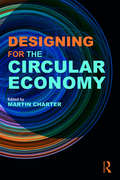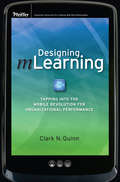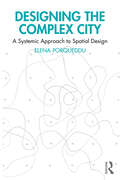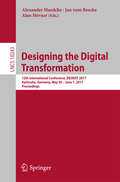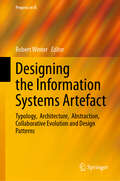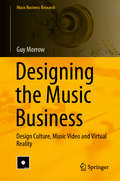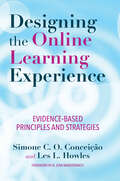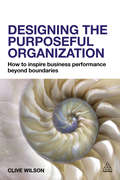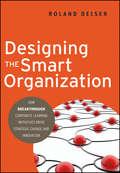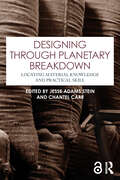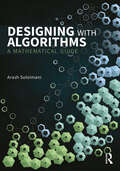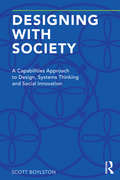- Table View
- List View
Designing for the Circular Economy
by Martin CharterThe circular economy describes a world in which reuse through repair, reconditioning and refurbishment is the prevailing social and economic model. The business opportunities are huge but developing product and service offerings and achieving competitive advantage means rethinking your business model from early creativity and design processes, through marketing and communication to pricing and supply. Designing for the Circular Economy highlights and explores ‘state of the art’ research and industrial practice, highlighting CE as a source of: new business opportunities; radical business change; disruptive innovation; social change; and new consumer attitudes. The thirty-four chapters provide a comprehensive overview of issues related to product circularity from policy through to design and development. Chapters are designed to be easy to digest and include numerous examples. An important feature of the book is the case studies section that covers a diverse range of topics related to CE, business models and design and development in sectors ranging from construction to retail, clothing, technology and manufacturing. Designing for the Circular Economy will inform and educate any companies seeking to move their business models towards these emerging models of sustainability; organizations already working in the circular economy can benchmark their current activities and draw inspiration from new applications and an understanding of the changing social and political context. This book will appeal to both academia and business with an interest in CE issues related to products, innovation and new business models.
Designing mLearning
by Clark N. QuinnMobile is a powerful new tool for supporting organizational performance, including a wide-variety of learning opportunities including innovation, collaboration, research, and design. Mobile generates new products, services, and helps solve problems. Whether providing needed tools, augmenting learning, or connecting individuals, mobile devices are empowering individuals and organizations.Designing mLearning is a hands-on resource that presents step-by-step guidance for designing, delivering, and deploying mobile solutions, covering both the background model and pragmatic considerations for successfully navigating mobile projects. The book takes an integrated approach to mobile learning regardless of the device used. Written by Dr. Clark Quinn, a noted leader in the mLearning revolution, Designing mLearning debunks commonly held myths about mLearning, defines the myriad opportunities for mobile, contains real-world, illustrative examples, includes implementation concerns, and places mobile learning in an overall strategic plan.Designing mLearning is written for instructional designers, developers, media experts, managers, and anyone with responsibility for supporting performance in organizations. While the focus is on the design of solutions, the book addresses the critical organizational issues to assist the larger agenda of mobilizing the organization.The information outlined in this groundbreaking guide can be applied across the mobile device spectrum and provides a systematic and integrated suite of conceptual frameworks to guide designers to pragmatic and effective solutions."Quinn takes you by the hand and leads you carefully and comprehensively through the m-learning maze of devices, models, examples, and designs, at the same time demonstrating that mobile learning is more than being about learning, but is also about performance."--Jane Hart, founder & CEO, Centre for Learning and Performance Technologies"Stop thinking mLearning is miniaturized eLearning. Just as digital video has enabled entirely new forms of entertainment and communication, mLearning enables powerful new (and old) performance solutions at very low costs. Clark omits the deafening hyperbole and delivers today's best source of clear, complete, and useful mLearning guidance for us all."--Michael Allen, CEO, Allen Interactions"The future is mobile. It will rock you more than the web did. And Clark Quinn has written the missing manual."--Jay Cross, CEO, Internet Time, and author, Informal Learning"Those of us in learning and development know we spend a disproportionate amount of time on formal training, missing opportunities to support workers where real learning occurs: in work, every day. With a wealth of examples, Clark Quinn provides a clear, useful guidebook for using 21st-century tools to support our performers as they enact their work and apply new learning."--Jane Bozarth, Ed.D., author, Social Media for Trainers and Better Than Bullet Points"Yes, this is a handy book about mobile learning and support. But it's also a thoughtful nudge towards rethinking what we mean when we say we are educators."--Allison Rossett, San Diego State University"Clark Quinn sets the pace for a swift race toward mobile everything. His thought-leadership and focus on solutions that work make him the one to watch, to read, and to learn from now!"--Marcia Conner, advisor in business culture and collaboration, co-author of The New Social Learning: A Guide to Transforming Organization Through Social Media
Designing the Business Model Architecture: Executing Specific Growth Opportunities Using Discovery-Driven Planning
by Ian C. Macmillan Rita Gunther McgrathIn reality, your strategy is what projects you are working on and how you run them, not what's printed on an annual report or posted on your website. Thus, whether you are a CEO or someone else in the organization, you must have the right practices in place to manage strategic growth initiatives effectively. This chapter addresses how to design the fundamental business that will generate growth, including establishing the viability of a business, given corporate requirements, analyzing the unit of business, analyzing the nearest competitive offer, and identifying subsequent key metrics. This chapter is excerpted from "Discovery-Driven Growth: A Breakthrough Process to Reduce Risk and Seize Opportunity."
Designing the Complex City: A Systemic Approach to Spatial Design
by Elena PorquedduHow can designers address the emergent self-organizing nature of complex urban environments? Designing the Complex City highlights how both an excess and a lack of design control might contrast the lively complexity of cities, their adaptive and evolutionary capacity. By using key concepts from systems thinking, complexity sciences, life sciences, cognitive sciences, and social sciences, the book frames a systemic spatial design approach aimed at enhancing the potential of different spatial design disciplines to navigate place-specific emergent transformations without overdetermining their formal outcome. A range of heterogeneous case studies, developing at different scales, show how embracing a design approach that is embodied, open-ended, contextually responsive, incremental and adaptive does not question the relevance of designers’ specific skills in shaping the physical structure of cities; it may rather increase their potential to effectively intervene in complex adaptive cycles of urban decay and self-regeneration.Designing the Complex City provides insights for students, researchers, and academics in architecture, interior design, urban and landscape design, planning theory, and urban studies. It is essential reading for all designers who seek to proactively and meaningfully intervene in spontaneous socio-spatial dynamics.
Designing the Customer-Centric Organization
by Jay R. GalbraithDesigning the Customer-Centric Organization offers today???s business leaders a comprehensive customer-centric organizational model that clearly shows how to put in place an infrastructure that is organized around the demands of the customer. Written by Jay Galbraith (the foremost expert in the field of organizational design), this important book includes a tool that will help determine how customer-centric an organization is- light-level, medium-level, complete-level, or high-level- and it shows how to ascertain the appropriate level for a particular institution. Once the groundwork has been established, the author offers guidance for the process of implementing a customer-centric system throughout an organization. Designing the Customer-Centric Organization includes vital information about structure, management processes, reward and management systems, and people practices.
Designing the Digital Transformation: 12th International Conference, DESRIST 2017, Karlsruhe, Germany, May 30 – June 1, 2017, Proceedings (Lecture Notes in Computer Science #10243)
by Alexander Maedche, Jan vom Brocke and Alan HevnerThis book constitutes the proceedings of the 12th International Conference on Design Science Research in Information Systems and Technology, DESRIST 2017, held in May/June 2017 in Karlsruhe, Germany. The 25 full and 11 short papers presented in this volume were carefully reviewed and selected from 66 full and 19 short papers. The contributions are organized in topical sections named: DSR in business process management; DSR in human computer interaction; DSR in data science and business analytics; DSR in service science; methodological contributions; domain-specific DSR applications; emerging themes and new ideas; and products and prototypes.
Designing the Forest and other Mass Timber Futures
by Lindsey WikstromIf we want to continue existing on this earth, an era of renewable energy and materials is urgently needed. What role could mass timber, with its potential to replace concrete and steel, have in ensuring the planet’s survival? This book retraces wood’s passage from stewarded seed in the soil of forests, to harvested biomass, to laminated walls in a living room, through to its disassembly, pausing at each step in the supply chain of mass timber to consider the labor and economies involved, looking closely at the way wood is grown, sourced, and transported, and its impacts on the biodiversity of the forest and the health of our ecosystems. It explores why historically entrenched contexts of extractivism make such sensitive approaches difficult to cultivate across landscapes and industrial frameworks. Along the way, common assumptions about mass timber are debunked, including its fire performance, its strength, and its role in carbon sequestration. Having identified contemporary technical, cultural, and spiritual gaps preventing the transition towards a fully timber built environment, it outlines how we might move forward. A more sensitive species-based methodology is essential, with designers as choreographers of carbon, transferring and trading between forest, factory, site, and beyond. This will be an important read for anyone interested in our built environment and how to design it to be non-extractive, especially those with an interest in architecture, urbanism, forests, ecology, and timber, as well as students of architecture and design interested in the generative nature of materials and design processes.
Designing the Future of Work: Atlassian's Distributed Work Practices
by Ashley Whillans Gabriel Rondon IchikawaIn early 2020, the software company Atlassian made a bold commitment: employees could work from anywhere-forever. While many tech peers reversed course on remote work, Atlassian worked to optimize their fully distributed model across 13 countries. This case follows Annie Dean, Head of Team Anywhere, as she leads the development of data-driven work practices such as redesigning meetings, office spaces, and team rituals to support Atlassian's globally distributed workforce. By 2024, these internal practices had become more than an HR initiative, they were central to Atlassian's current business strategy. The company began embedding lessons from its internal experiments into its collaboration software, turning its workforce into a petri-dish for future products. But selling these practices to enterprise customers posed a new challenge: unlike Atlassian's traditional self-serve model, distributed work transformation required hands-on support, strategic advising, and cultural change, capabilities that the company had not previously built into its go-to-market approach. As Dean prepared for an executive strategy meeting, she and Atlassian's leadership faced key questions: how to scale internal practices without losing flexibility, how tightly to integrate work practices into products, and how to support customers through changes that required not just tools, but new ways of working. This case explores what it takes to transform the future of work from the inside out and to sell that transformation at scale.
Designing the Human Business: Leveraging Design Thinking to craft powerful and innovative business models
by Anthony MillsLaunch new ventures and grow existing businesses by discovering innovative solutions and business models that resonate with your customer's needs Key FeaturesLearn how to dissect business models and create new ones that unlock maximum valueDiscover how to use Design Thinking to deliver solutions that resonate with the marketIntegrate Design Thinking with business model innovation for scalable, innovative business designsPurchase of the print or Kindle book includes a free PDF eBookBook DescriptionGlobally, 275,000 new business ventures get launched every single day, and ninety percent of them fail. One of the most fundamental reasons for that is that they don’t solve a real market problem that a real market population has, in a way that resonates with that market and sells their solution. Consequently, they struggle to gain traction and attain scale. In this book, you’ll learn what business models are. Additionally, you’ll find out what business model innovation is and, ultimately, how to use Design Thinking to identify not just a winning value proposition but also bring that value proposition to the market in a way that resonates with customers. In doing so, you’ll be able to unlock maximum value for your business, allowing it to attain maximum scale through growing waves of adopters. By the end of this book, you’ll understand what you need to do to uncover your target markets’ ‘reason to buy’, as well as how to wrap a winning business model around that reason so that your business can gain traction and achieve scale.What you will learnUnderstand the fundamentals of business model innovation and its role in driving organizational successExplore how to craft human-centered business models and their significanceMaster Design Thinking for resonant value propositions and business modelsDiscover innovative solutions that address genuine customer aspirationsFind out how quantitative and artificial intelligence approaches enhance human-centered validationOvercome past marketplace failures with innovative ideasBuild a human-centered business model that withstands market forcesWho this book is forThis book is for individuals in leadership roles like CSOs, CIOs, CTOs, CEOs, and those responsible for launching and growing new business ventures. It builds on your existing business knowledge, showing you how to design businesses that grow inherently by connecting with markets through innovative, human-centered solutions and business models. A foundational understanding of business operations is assumed.
Designing the Information Systems Artefact: Typology, Architecture, Abstraction, Collaborative Evolution and Design Patterns (Progress in IS)
by Robert WinterThis book provides essential methodological guidance on IS artifacts to address key challenges in Design Science Research (DSR). As a foundation for understanding and categorizing DSR artifacts, it proposes a more differentiated, empirically justified DSR artifact typology. Additionally, it presents an artifact type-agnostic architecture model for DSR project knowledge, offering concrete recommendations for researchers and practitioners alike. As most DSR artifacts exist on a wide range of abstraction levels, an artifact type-agnostic perspective of abstraction is presented and a set of fundamental generalization and contextualization operations is proposed. The concept of managed evolution and insights from tension theory are used to propose a collaboration model, fostering effective interaction between researchers and practitioners in DSR. Finally, by associating empirically validated classes of functional requirements with solution classes, candidates for general constructional patterns are developed. All chapters share a contemporary understanding of DSR artifacts as complex combinations of IT, organizational, and use elements – ranging from algorithms to informal interventions in organizations. These artifacts are based on both descriptive knowledge and empirical justifications (or ideally both) and are exemplified by contextualized instantiations that solve situated problems in organizations or administrations. This book provides a unified and practical approach to advancing DSR, offering insights for both advanced academic researchers and industry practitioners whose work involves IS artifacts.
Designing the Music Business: Design Culture, Music Video and Virtual Reality (Music Business Research)
by Guy MorrowThis book addresses the neglect of visual creativities and content, and how these are commercialised in the music industries. While musical and visual creativities drive growth, there is a lack of literature relating to the visual side of the music business, which is significant given that the production of meaning and value within this business occurs across a number of textual sites.Popular music is a multimedia, discursive, fluid, and expansive cultural form that, in addition to the music itself, includes album covers; gig and tour posters; music videos; set, stage, and lighting designs; live concert footage; websites; virtual reality/augmented reality technologies; merchandise designs; and other forms of visual content. As a result, it has become impossible to understand the meaning and value of music without considering its relation to these visual components and to the interrelationships between them. Using design culture theory, participant observation, interviews, case studies, and a visual methodology to explore the topic, this research-based book is a valuable study aid for undergraduate and postgraduate students of subjects including the music business, design, arts management, creative and cultural industries studies, business and management studies, and media and communications.
Designing the Online Learning Experience: Evidence-Based Principles and Strategies
by Simone C. Conceição Les HowlesThis book provides instructors with a holistic way of thinking about learners, learning, and online course design. The distinctive strategies derived from an integrated framework for designing the online learning experience help create an experience that is more personalized, engaging, and meaningful for online learners.The focus of this book is on the learners and the design of their online learning experiences. The authors refer to learning design instead of instructional design – which focuses on instruction and places the instructor at the center stage of the process. Therefore, the focus is on approaching a learner’s online course experience as a journey consisting of a combination of learning interactions with content, instructor, and other learners. In most online courses, instructors and learners are separated in time and space and depend on technology to facilitate interactions that often lack a strong personal dimension. As online learning continues to proliferate and mature, the emphasis on simply making content available to students online is no longer acceptable. Creating online courses now requires a new way of thinking that incorporates new design ideas and approaches from a variety of fields; it also requires a new set of learning design skills for instructors and course designers.Organized into eight chapters, this volume focuses on enhancing online learning experiences for each of the major aspects of an online course, providing evidence-based principles and strategies to promote learner engagement and deep learning. The concluding chapter provides an example illustrating a real-world application of the principles and strategies covered in the book, using Design Thinking to create learning experiences.This book provides strategies for approaching the learning experience from an integrative perspective for both experienced online instructors and those new to online course design. These strategies are based on evidence-based learning design principles and encourage the reader to adopt an empathic mindset focused on the experience of the learner.
Designing the Purposeful Organization
by Clive WilsonGlobalization, competition and recession have created an overwhelming pressure on organizations to deliver growth. This has often resulted in tough performance targets being pushed down the line. Hard-hitting management may deliver short-term results but in the longer term key people burn out or leave, and business performance falls back. Designing the Purposeful Organization explains how to implement a more enlightened and authentic leadership style that aligns people's strengths to the delivery of a compelling future. It draws on a unique framework that helps leaders manage the eight elements essential for high performance: purpose, vision, engagement, structure, character, results, success and talent. It moves beyond the boundaries of transactional performance (pay me X and I'll deliver Y) to a purpose-centred performance that releases talent, creativity and engagement. It features case studies from Google, Whole Foods Market, the NHS and the London 2012 Olympics and is ideal for practitioners in organization development, senior HR managers and business leaders. This book demonstrates how business performance can be inspired beyond boundaries by aligning people to a compelling purpose.
Designing the Purposeful World: The Sustainable Development Goals as a Blueprint for Humanity
by Clive WilsonIn September 2015, at the United Nations, world leaders agreed on seventeen Sustainable Development Goals or SDGs. This book extrapolates the SDGs into the idea of a purposeful world. In this context, the purpose for humanity is to thrive sustainably alongside other life forms and to consciously celebrate the process. The SDGs serve as a powerful vision, time-stamped at the 2030 time horizon, not just for world leaders but for us all. However, faced with the challenges of implementing the SDGs, we (including business leaders, government leaders and anyone wishing to make a difference) can feel overwhelmed. Wilson takes the reader on a journey of thought and invites them to work out their personal role in sustainability as well as their collaborative role alongside others in their communities and organisations. Written in a very accessible style, the book celebrates some of the many achievements made by ordinary people as a catalyst for hope, sets out a number of achievable goals and provides exercises to enable the reader to adopt practices that help to make a difference. It is the perfect book to help turn the SDGs into action at every level – governmental, organisational and personal.
Designing the Smart Organization
by Roland DeiserFilling a gap in the literature, this book offers an innovative interdisciplinary approach to learning for corporate strategic development, linking the domains of strategy, organizational design, and learning. To demonstrate how this process drives the boundaries of the practice way beyond the established notion of simple training and management education, the book is filled with detailed case studies from leading global organizations, including Siemens, ABB, BASF, the US Army, PricewaterhouseCoopers, EADS, Novartis, and more. These studies reveal how large-scale corporations are using the power of dynamic corporate learning approaches to drive innovation, enhance cultural values, master post-merger integration, transform business models, enhance leadership culture, build technological expertise, foster strategic change processes, and ultimately increase bottom line results. For any company that wants to compete in the 21st century, Designing the Smart Organization offers inspiring perspectives for integrating corporate learning as a core business practice that will create sustainable strategic and organizational capabilities.
Designing the Successful Corporate Accelerator: How Startups And Big Companies Can Get With The Program
by Jules Miller Jeremy KaganAccelerators can be powerful tools to build and transform businesses in a short period of time, which is why they have spread like wildfire in the corporate world. Designing the Successful Corporate Accelerator gives readers the tools to design, create, and manage successful corporate accelerators that achieve results time and time again. Authors Jules Miller and Jeremy Kagan are seasoned professionals in this space, and combine global market research, interviews with accelerator leaders, and their own experience launching and running accelerators to share what works—and what doesn’t. The first half of the book takes a broader look at corporate innovation as a whole and how accelerators fit in, then the second half offers practical advice for how to launch, run, and manage world-class accelerator programs. Perfect for executives, employees, founders, investors, intrapreneurs, and entrepreneurs, Designing the Successful Corporate Acceleratoris a practical guidebook for anyone with a passion for corporate innovation and entrepreneurship.
Designing through Planetary Breakdown: Locating Material Knowledge and Practical Skill
by Jesse Adams Stein Chantel CarrIn an era of profound environmental and geopolitical uncertainty, Designing through Planetary Breakdown offers fresh perspectives on design’s evolving role in the face of planetary change. This unique collection emphasises practices and perspectives at the edges of conventional design, encompassing craft, material knowledge, repair, manual skills, creative practice and non-professional design, to reveal how design can address urgent challenges in grounded, hands-on ways.Structured into two sections – Skills and Capacities, and Care and Generative Practices – the chapters cover a rich range of topics examining both traditional and emerging approaches to making, caring and maintaining. Readers will find reflections on community-led adaptive urban heat strategies in Western Sydney, First Nations’ perspectives on design labour, repair-led design education initiatives, and the ethical and social dimensions of global supply chains. The book journeys through a wide range of empirical examples, including from Cuba, Indonesia, Spain and Australia, offering insights into generative transformations of materials and technologies. It demonstrates how design, expanded beyond the traditional professional confines, can foster practical responses to global issues.Designing through Planetary Breakdown is ideal for scholars, students, designers and craftspeople across design studies, design anthropology, repair and discard studies, craft studies and more broadly in the humanities and social sciences. Practical and deeply social, this collection offers a call to action: a guide for all hands to shape a future not just of survival, but of regeneration and collective action. The Introduction and Chapter 3 of this book is freely available as a downloadable Open Access PDF at http://www.taylorfrancis.com under a Creative Commons [Attribution-Non Commercial-No Derivatives (CC BY-NC-ND)] 4.0 license.
Designing with Algorithms: A Mathematical Guide
by Arash SoleimaniComputing is revolutionizing the creative process, transforming how designers approach ideation, prototyping, fabrication, communication, and representation. Yet many lack the foundational knowledge needed to fully harness its potential. Designing with Algorithms: A Mathematical Guide bridges this gap, offering a comprehensive, step-by-step exploration of algorithmic practices applicable across diverse design fields.This guide begins with foundational theories, illuminating the role of mathematics and computational logic in design thinking. It progresses to practical techniques for creating parametric 2D and 3D geometries, grid systems, patterns, forms, and fonts. The book culminates in real-world case designs, showcasing diverse applications of generative algorithms across urban design, architecture, graphic design, typography, fashion, and more. Unlike software-specific guides, this book emphasizes process and adaptability, teaching readers to think algorithmically and develop skills transferable to any programming platform.Whether you’re a student, practitioner, or enthusiast, this book empowers you to future-proof your design practice and unlock the creative potential of computation.
Designing with Society: A Capabilities Approach to Design, Systems Thinking and Social Innovation
by Scott BoylstonThis book explores an emerging design culture that rigorously applies systems thinking to the practice of design as a form of facilitating change on an increasingly crowded planet. Designers conversant in topics such as living systems, cultural competence, social justice, and power asymmetries can contribute their creative skills to the world of social innovation to help address the complex social challenges of the 21st century. By establishing a foundation built on the capabilities approach to human development, designers have an opportunity to transcend previous disciplinary constraints, and redefine our understanding of design agency. With an emphasis on developing an adaptability to dynamic situations, the cultivation of diversity, and an insistence on human dignity, this book weaves together theories and practices from diverse fields of thought and action to provide designers with a concrete yet flexible set of actionable design principles. And, with the aim of equipping designers with the ability to drive long-term, sustainable change, it proposes a new set of design competences that emphasize a deeper mindfulness of our interdependence; with each other, and with our life-giving natural systems. It’s a call to action to use design and design thinking as a tool to transform our collective worldviews toward an appreciation for what we all hold in common; a hope and a belief that our future is a place where all of humankind will flourish.
Designing with Sound: Fundamentals for Products and Services
by Amber Case Aaron DaySound can profoundly impact how people interact with your product. Well-designed sounds can be exceptionally effective in conveying subtle distinctions, emotion, urgency, and information without adding visual clutter. In this practical guide, Amber Case and Aaron Day explain why sound design is critical to the success of products, environments, and experiences.Just as visual designers have a set of benchmarks and a design language to guide their work, this book provides a toolkit for the auditory experience, improving collaboration for a wide variety of stakeholders, from product developers to composers, user experience designers to architects. You’ll learn a complete process for designing, prototyping, and testing sound.In two parts, this guide includes:Past, present, and upcoming advances in sound designPrinciples for designing quieter productsGuidelines for intelligently adding and removing sound in interactionsWhen to use voice interfaces, how to consider personalities, and how to build a knowledge map of queriesWorking with brands to create unique and effective audio logos that will speak to your customersAdding information using sonification and generative audio
Designing, Conducting, and Publishing Quality Research in Mathematics Education (Research in Mathematics Education)
by Keith R. LeathamThe purpose of this book is to collect, organize and disseminate collective wisdom with respect to designing, conducting, and publishing quality research in mathematics education. This wisdom will be gleaned from among those who, over the past several decades, have been instrumental in guiding the field in the pursuit of excellence in mathematics education research—insightful editors, educative reviewers, prolific writers, and caring mentors. Each chapter is written to the novice researcher with the intent of aiding them in avoiding common pitfalls, navigating difficult intellectual terrain, and understanding that they are not alone in experiencing rejection, frustration, confusion, and doubt. This book differs from existing literature in the sense that it is written about the enterprise of designing, conducting and publishing research in mathematics education as opposed to being reports of the results of such work. It also differs in the sense that it is written with the intent to mentor the rising generation as opposed to capture the state of the field (as would happen in a handbook, for example). It is written for the express purpose of helping the field work collectively to aid in the often isolated enterprise of mentoring new researchers. The primary audience is a potentially wide one: graduate students, novice researchers, graduate faculty, advisors, and mentors – or anyone seeking to improve their own abilities to design, conduct, and publish quality research in mathematics education.
Designing, Selecting, Implementing and Using APS Systems
by Vincent C. S. Wiers A. Ton G. De KokCommercial advanced planning and scheduling (APS) systems have been around for about 25 years and have seen widespread adoption in a variety of companies. The promises made by APS system implementations are high, and at the same time, APS projects are complex, costly, and carry a significant risk of failure. There is a great need for guidance on how to successfully implement APS systems, which is why this book was written. In this book, we aim to discuss all facets of APS implementation, from theoretical background to definition, vendor selection, system design and the implementation process. In addition, this book helps readers understand how the underlying concepts were formed, why a concept will work in practice, and when it will not. The contents of this book are based on many years of academic research and APS implementation experience. It draws together theory and practice in production control and explains how theories can be applied to support planning and scheduling processes in practice. This book will help anyone involved in APS implementations to achieve success: human planners generate better plans than before, using the APS.
Designs by Kate: The Power of Direct Sales
by Sarah L. Abbott John DeightonThe sales representatives at Designs by Kate (DBK) sell private label jewelry at hosted parties and through online social media channels. They are also responsible for recruiting, training, and managing new sales reps. CEO and founder Kate Creevey designed the commission plan to encourage sales reps to build teams and become "leaders" for their teams. The strategy has been very successful over the company's first five years. Now the CEO is concerned that growth in top-line revenue is slowing, possibly due to an unwillingness by current sales representatives to build and manage their own sales teams. A survey reveals that many sales reps believe their incomes from jewelry sales decline when they add members to their sales teams due to increased competition for hosting parties within the same geographic area. The CEO must revisit the commission structure to determine if it is still an effective incentive. The case includes a quantitative assignment that students should complete as part of case analysis.
Desigualdad
by Nicolás EyzaguirreUn contundente ensayo sobre los orígenes históricos de la desigualdad en Chile y sobre cómo salir de esta fatídica condición Durante más de dos siglos Chile ha sido un país construido sobre la base de instituciones oligárquicas, las cuales han impedido un equitativo progreso social. Es lo que algunos analistas, a mediados del siglo XX, denominaron como "desarrollo frustrado". Bajo la modalidad de análisis ofrecida por la "economía comprada" (tal y como lo hicieran Robinson y Acemoglu en Por qué fracasan los países), Nicolás Eyzaguirre compara el desarrollo económico-político latinoamericano con el caso chileno, haciendo un repaso histórico que va desde las ciudades-estado griegas, pasando por el descubrimiento del "Nuevo Mundo" a la travesía chilena durante los siglos XIX y XX; esto, con el propósito de ofrecer un nuevo panorama para el futuro.
Desinformationsangriffe auf Unternehmen abwehren: Das dunkle Geschäft mit Fake News & Co und wie man sie bekämpft
by Uwe WolffFake News ist für die allermeisten ein Begriff, den sie mit Politik und politischen Kampagnen in Verbindung bringen. Die verheerenden Auswirkungen sind bekannt (Brexit, Trump, AfD) Doch erst jetzt realisieren Unternehmen und Unternehmenslenker, dass auch sie Zielscheibe von Fake News werden können. Die ersten Unternehmen in Deutschland haben diese Desinformationsattacken bereits zu spüren bekommen. Die Folge: Wertverfall des Unternehmens, Aktienabstürze, Reputationsschaden sowie verunsicherte Mitarbeiter, Geschäftspartner und Banken. Die Ziele und Motive der Kommunikationsattacken sind vielfältig: Sie reichen von verärgerten Ex-Mitarbeitern, aggressiven Mitbewerbern bis hin zu Hedge-Fonds, die ein Unternehmen übernahmereif schießen wollen oder auf fallende Aktienwerte wetten. Den modernen Kommunikationsattacken steht ein wirkungsvolles und breit gefächertes Waffenarsenal im Bereich Internet und Social Media zur Verfügung, mit denen sich Fake News in Minutenschnelle Wirksam verbreiten lassen, sodass Unternehmen kaum mehr die Zeit haben, sich dagegen wirkungsvoll zu wehren. Dieses Buch richtet den Blick auf die neue Situation, in der sich die Unternehmen empfinden, und beschreibt die die empfindlichen Stellen. Es erläutert Kommunikationsattacken anhand von Beispielen und liefert zudem eine Handreichung für Unternehmen in Sachen Prävention und Detektion, aber auch im Abwehrkampf gegen gezielte unternehmensschädigende Informationsattacken.
